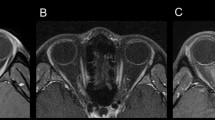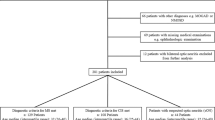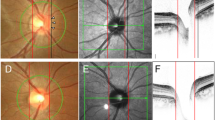Abstract
Purpose
Assess the prevalence and evolution of PHOMS in optic neuritis.
Methods
We analysed the medical files of 126 patients included in the OCTON cohort. Patients’ medical files, digital retinal images and OCT examinations were reviewed, searching for optic nerve head oedema and PHOMS at the initial presentation and during the follow-up.
Results
We included 102 patients in the final analysis. Twenty-nine (29) eyes had optic nerve head oedema at the initial presentation. PHOMS were found to be present in 8 eyes affected with optic neuritis. All cases of PHOMS were associated with optic nerve head oedema. All the PHOMS decreased in size and disappeared with the improvement of the oedema.
Discussion
Our results show that PHOMS is not a common sign of optic neuritis. We didn’t observe any case of PHOMS in the absence of optic nerve head oedema in eyes with optic neuritis. PHOMS seem to be a rare sign of optic neuritis associated to optic nerve head oedema, and they tend to disappear with the improvement of the optic nerve head oedema. We suggest that the presence of PHOMS in optic neuritis eyes with no optic nerve oedema should be a considered warning sign.
This is a preview of subscription content, access via your institution
Access options
Subscribe to this journal
Receive 18 print issues and online access
$259.00 per year
only $14.39 per issue
Buy this article
- Purchase on Springer Link
- Instant access to full article PDF
Prices may be subject to local taxes which are calculated during checkout



Similar content being viewed by others
Data availability
The datasets generated during and/or analysed during the current study are not publicly available due to the privacy of medical files but are available from the corresponding author on reasonable request.
References
Malmqvist L, Bursztyn L, Costello F, Digre K, Fraser JA, Fraser C, et al. The optic disc drusen studies consortium recommendations for diagnosis of optic disc drusen using optical coherence tomography. J Neuroophthalmol. 2018;38:299–307.
Pichi F, Romano S, Villani E, Lembo A, Gilardoni F, Morara M, et al. Spectral-domain optical coherence tomography findings in pediatric tilted disc syndrome. Graefes Arch Clin Exp Ophthalmol. 2014;252:1661–7.
Petzold A, Biousse V, Bursztyn L, Costello F, Crum A, Digre K, et al. Multirater validation of peripapillary hyperreflective ovoid mass-like structures (PHOMS). Neuroophthalmology. 2020;44:1–2.
Fraser JA, Sibony PA, Petzold A, Thaung C, Hamann S, ODDS Consortium. Peripapillary hyper-reflective ovoid mass-like structure (PHOMS): an optical coherence tomography marker of axoplasmic stasis in the optic nerve head. J Neuroophthalmol. 2021;41:431–41.
Petzold A, Coric D, Balk LJ, Hamann S, Uitdehaag BMJ, Denniston AK, et al. Longitudinal development of peripapillary hyper-reflective ovoid masslike structures suggests a novel pathological pathway in multiple sclerosis. Ann Neurol. 2020;88:309–19.
Deschamps R, Shor N, Vignal C, Guillaume J, Boudot de la Motte M, Salviat F, et al. Prospective longitudinal study on prognostic factors of visual recovery and structural change after a first episode of optic neuritis. Eur J Neurol. 2022;29:2781–91.
Gala F. Magnetic resonance imaging of optic nerve. Indian J Radiol Imaging. 2015;25:421–38.
Acknowledgements
The authors would like to thank David Pena-Guzman, PhD, for his advice and contribution in finalising the manuscript.
Author information
Authors and Affiliations
Contributions
AA, MP, RD, CV, and RH: design and conduct of the study. AA: data collection. AA and RH: data analysis and interpretation. AA and RH: writing of the manuscript. AA, MP, RD, CV, and RH: critical review and final approval of the manuscript.
Corresponding author
Ethics declarations
Competing interests
The authors declare no competing interests.
Additional information
Publisher’s note Springer Nature remains neutral with regard to jurisdictional claims in published maps and institutional affiliations.
Rights and permissions
Springer Nature or its licensor (e.g. a society or other partner) holds exclusive rights to this article under a publishing agreement with the author(s) or other rightsholder(s); author self-archiving of the accepted manuscript version of this article is solely governed by the terms of such publishing agreement and applicable law.
About this article
Cite this article
Aziria, A., Philibert, M., Deschamps, R. et al. Are PHOMS a clinical sign of optic neuritis?. Eye 37, 2776–2780 (2023). https://doi.org/10.1038/s41433-023-02419-w
Received:
Revised:
Accepted:
Published:
Issue Date:
DOI: https://doi.org/10.1038/s41433-023-02419-w



